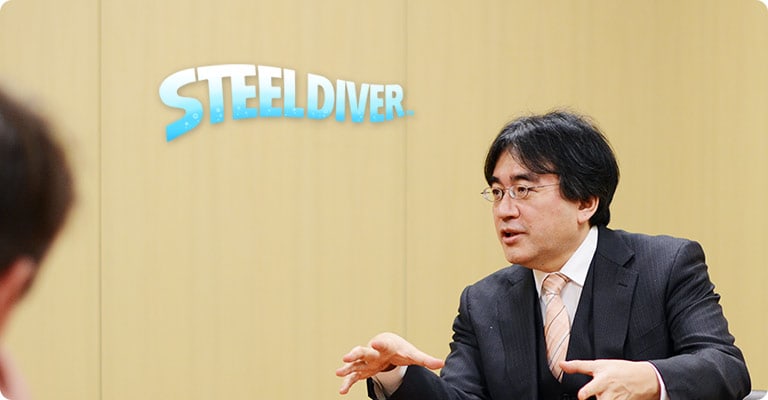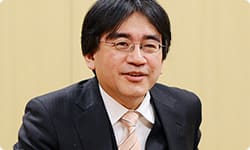Conquering Land, Sea and Sky
Sugiyama-san, Steel Diver has been in the works for some time now, hasn't it?
Yes. We first exhibited the Nintendo DS system at the E3 2004.5Steel Diver began with our technical demo there.
My impression back then was that it was well received. A lot of people said they enjoyed playing it. But it didn't see the light of day right away. After that, you were busy developing Wii Fit6, among other things.
Yes.
5. E3 (Electronic Entertainment Expo): A video game trade show usually held once a year in Los Angeles.
6. Wii Fit: A fitness type game released for the Wii console in December 2007.
When did you start coming under pressure to polish it up?
Quite awhile after that E3. NOA (Nintendo of America) wanted us to release it for the Nintendo DSi system.
Oh? Is that right?
Yes. (firmly)
I started saying, "Finishing that up is your job," every time I saw you.
Yes. You did. (laughs)
I kept pecking away at him. "Oh, by the way, how's that coming along?" "You're going to finish that sometime, right?" "What are you doing about that?"
So Miyamoto-san brought it up every time he saw you. (laughs)
Yeah. He wouldn't let up. (laughs)
The staff at NOA said it was fun, and Giles's team had just opened up, so I said to Sugiyama-san, "Why don't you work on it together?"
Why did you want to work with Giles's team on Steel Diver?
Simply put, I felt like the theme was right for them. As mentioned earlier, we had worked together for a long time, so I knew his strengths. And Vitei is in Kyoto, so…
The company was nearby, so I could visit every day.
It was great for us that you could come every day. We could talk over every little thing right away and fine tune the game's operability daily, so development proceeded smoothly.
Giles's presence in Kyoto was very beneficial for the progress of development.
That's right.
Also, the way we worked was much the same as it was when I was in EAD, so I was able to experience that atmosphere all over again.
How many people were on the team this time?
Vitei has 11 members.
This project included a mix of people from Vitei and EAD. Development proceeded as if EAD had temporarily expanded to Vitei. At first, there was only one mode and we were making it for the Nintendo DSi system.
That's right. At first, it was DSiWare7 for download. 7. DSiWare: Software download in exchange with points from the Nintendo DSi Shop to the Nintendo DSi and Nintendo DSi XL systems.
We began by making the game DSiWare, but we thought it had more potential to be something even bigger, so we decided to make it packaged Nintendo DS software for sale in shops. To that end, we began considering the addition of other modes, like another shot at something similar to Kaisen Game: Radar Mission8- which came up the other day in "Iwata Asks."
Miyamoto-san, you wanted another shot at that earlier game you had made for the Game Boy system.
Right. I needed a director to expand it, so I asked Imamura-san.
So, Imamura-san, he brought you in after the decision to release it as packaged software for the Nintendo DS system.
That's right. However, Miyamoto-san may not remember this—but before we kicked off Star Fox Command9, he asked me if I would do something with submarines.
I did?
You did. So I borrowed the ROM (a in-development version of the game) made by Sugiyama-san's team for the technical demo and studied that.
8: Kaisen Game: Radar Mission: A game released for the Game Boy system in October 1990 in Japan. It contained two naval battle games. One featured submarine torpedo warfare, while the other involved using radar to destroy an enemy fleet. Released as Radar Mission in North America. ("Kaisen" is the Japanese word for "naval battle.")
9. Star Fox Command: A shooting game released for the Nintendo DS system in August 2006.
Oh, way back then? Star Fox Command came out in 2006, but you started working on it after the E3 2004?
Right. But as we were discussing it, we began to think it might be a little underwhelming to sell as a packaged software. When submarines suddenly came up this time, I was like, "Here we go again!"
It was the return of the submarines! (laughs)
Yeah. They suddenly resurfaced! (laughs)
I think that was because I had my mind set thinking "Imamura-san's the one to make the submarine game!" (laughs)
I suppose you had that idea because I had made a bunch of vehicle-related games.
(laughs) You had done cars in F-Zero10 and fighter planes in Star Fox! 10. F-Zero: A racing game released for the Super Famicom (Super NES) system in November 1990.
And this time it's submarines! I've conquered land, sea and sky! (laughs)
Wow! So now you have conquered land, sky and sea! (laughs)
(laughs)
Yeah! (laughs) Anyway, we had decided to release it as packaged software for the Nintendo DS system, so we increased the number of levels for the previously existing Missions mode, gave Miyamoto-san his second shot at a strategic game by adding the Steel Commander mode, and added the Periscope Strike mode.
So it ended up with three modes.
Yes.
And they're all different.
Aside from it being a submarine game, could you say everything is different between the modes?
Yes. But there's a bonus periscope game included in Missions, and even in Steel Commander, the battles are played out in Periscope Strike. So there are a few periscope games, there's quite a mix overall.



